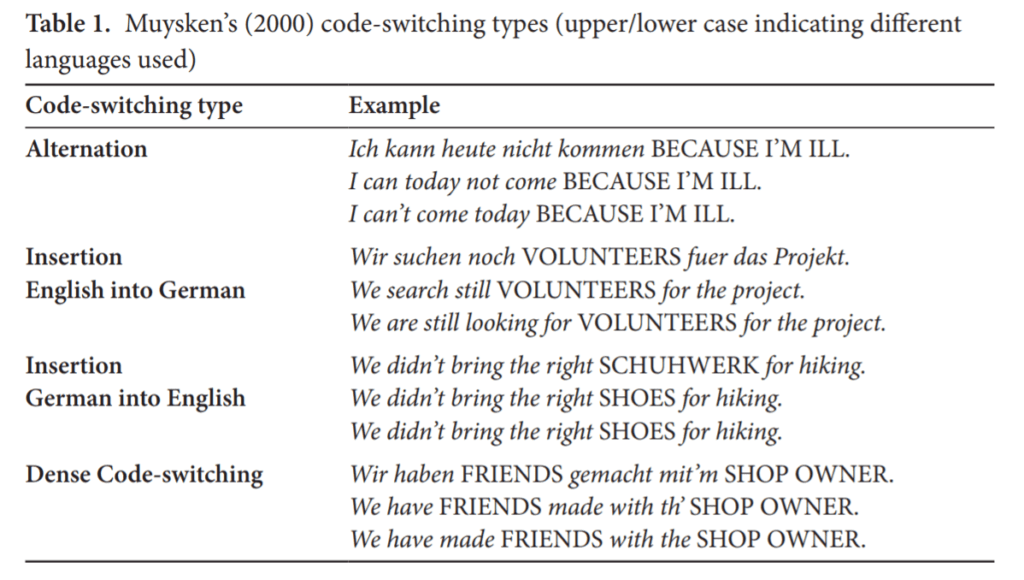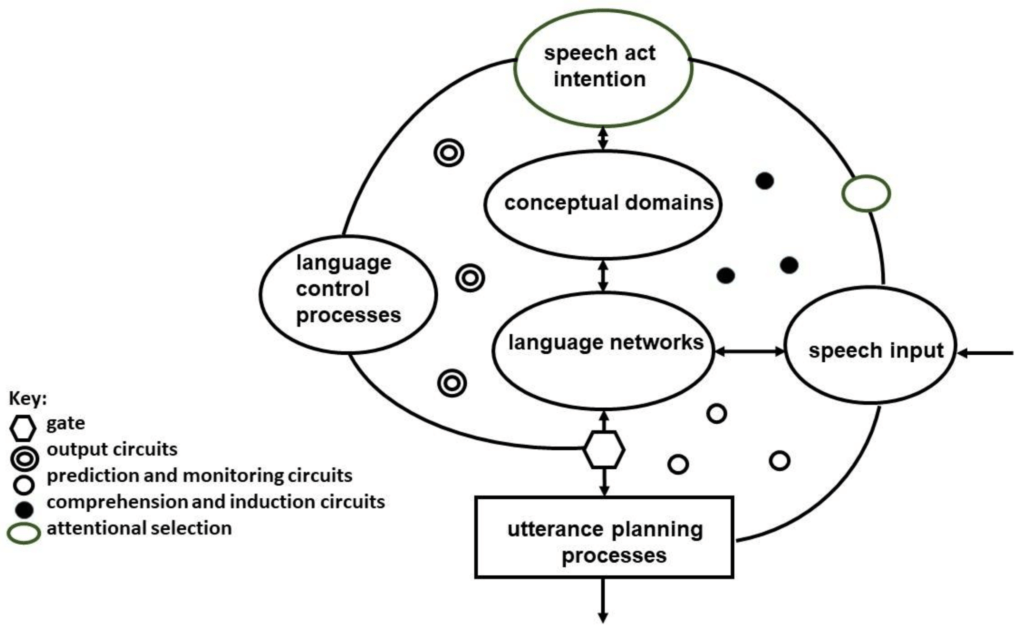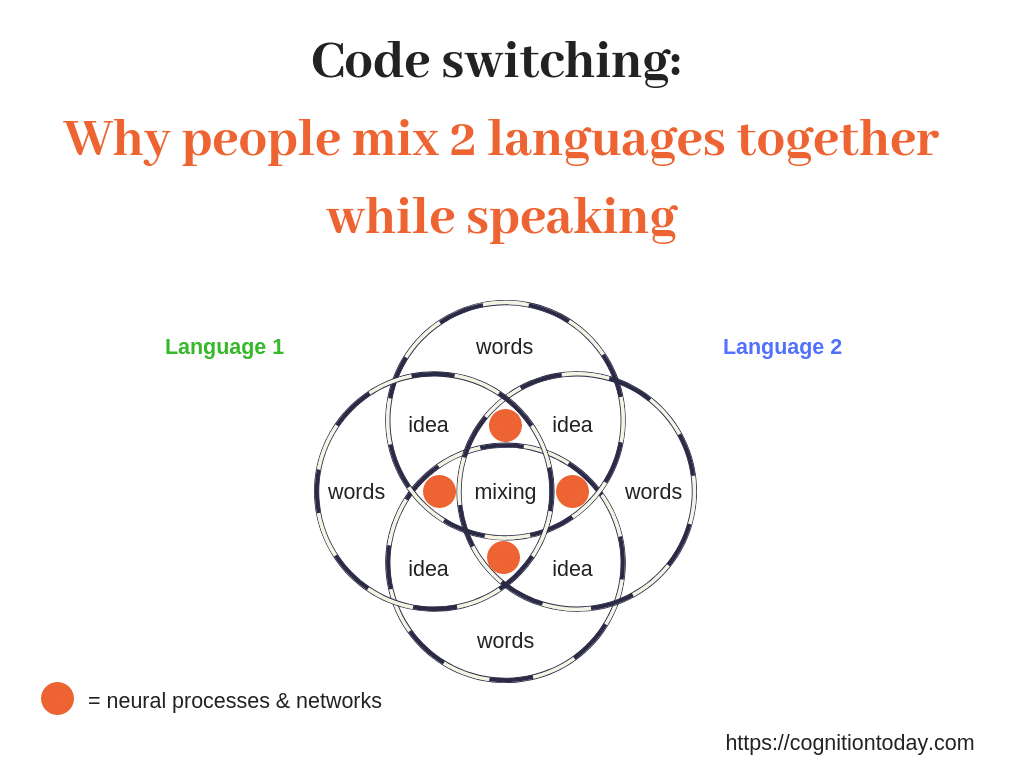When people mix two languages while speaking, we say they are
This can only happen if you know two or more language codes – complete languages, dialects, variations, pidgins, etc. are all codes.
Mesthrie, Swann, Deumart & Leap (2000) define code switching as the “switching back and forth of languages or varieties of the same language, sometimes within the same utterance.”
Some bilingual or multilingual people prefer to think in one language and then code switch while thinking about concepts which are new or learned in a different context.
People often mix 2 languages while speaking – that is called code switching. This happens because of neural, cognitive, social, and probabilistic interactions in the brain Share on XWhen people automatically mix 2 languages, there are 2 important factors to consider – cognition (all the processes involved in thinking) and the
We are now in the realm of psycholinguistics (psychology + linguistics) – the study of how language, in
Let us get to the explanation of why people mix 2 languages or code switch.
The first language acquired by a human is likely to form very robust widespread neural circuitry that governs that language. Let us call this Network A.
The second language acquired by a human is likely to form another circuitry only modestly associated with Network A simply because, languages build on one another. Let’s call this Network B.
Both these networks have unique as well as common features. Concrete objects like ‘a door’ and abstract concepts like ‘love’ can have various contexts and representative words. Some of these words have complex connotations in each language.
Knock, knock!
Who’s there?
A door
A door who?
Adore me.
English has one word for Love – Love. But it has borrowed more words from Greek (and other languages) to describe
- Eros – sexual passion
- Philia – deep friendship
- Ludus – playful love
- Agape, or love for everyone
- Pragma – longstanding love
- Philautia – love of the self
- Storge – love for family
Did the joke make you ludus me?
Each of these variations
You get the picture of how ideas are represented differently in different languages, right? It is important to understand that because that is the basis for why people code switch or mix up languages. It is also why some people feel certain ideas are better represented in their native language.
If you are an Indian from a city like Pune (my hometown) or Mumbai – you’ll know that many of us have used the word ‘shining’ with a very particular nuance – somewhat similar to gloating, showing-off, being smug, or proud, or vane. The word ‘
This is all to reinforce the fact that concepts, ideas, experiences, words, are all interlinked and form neural networks. And words in a language often represent the same idea differently as we saw with the word ‘love’. Let us get back to the 2 networks we talked about – native language (Network A) and a new language (Network B).
Words (or lemmas) carry a biological and a cognitive component which is not isolated. Both components are a part of their respective networks and these networks can overlap between words. The current understanding of code switching is grounded in this fact.
Multilingual people mix 2 languages while speaking because some words are better members of a particular language and some words, like cognates, form easy bridges to cross over Share on X
The process of code switching – cognition & neural probabilities
Now that there are two networks A & B associated together but formed differently, each one may be distinct enough for the brain to initiate speech and comprehension.
The key feature is internalization. Bilinguals, especially the ones who grow up with 2 or more languages, internalize network A & B (sometimes C, D, E…) to such an extent that they are heavily interlinked and very automatic. Automatic here means that the neurons engage themselves for speech and misc. language stuff without much conscious effort.
One can observe this while learning a new language later in life. One thinks a lot to choose the right word unless one practices enough to automate the new language. Yet, that language hardly ever becomes ‘fluent.’
For most of us, our first language is automatic. For many bilinguals, both languages are automatic and internalized. Most people think in the language that is internalized and automatic. The credit for this goes to the
Related: Learning new things creates new neural networks.
There are 3 types of code switching:
- Alternation: shifting between whole stretches and phrases of a language one after the other
- Insertion: mixing of individual lexemes or words of one language while speaking another language
- Dense code switching/congruent lexicalization: lexical and grammatical mixing and activation of 2 languages

The Extended Control Process Model of Code switching
David W. Green (2018) created a broad framework[2] which involves planning, control, speaker’s intention, conceptual details, and words to explain code switching.
Because conceptual activation triggers lexical and syntactic resources/inventories in 2 languages simultaneously for a bilingual person, there can be 2 outcomes – competition or cooperation between those inventories. His model suggests that the context and the speaker’s intention can control which outcome occurs. In a monolinguistic context, one language task schema (cognitive structure of intended language) can suppress another language schema via competition & inhibition and lower the likelihood of code switching. In a bilingual context, one language task schema can cooperate with another language schema and increase the likelihood of code switching.

The step before speaking a word is called utterance planning. Cognitive processes which control language are built on the speaker’s intentions, the conceptual meaning needed for communication and the global language network. The choice of language by the conversation partner can influence the language which is chosen by the speaker. There is a continuous attentional system which operates at multiple levels to comprehend what is heard and spoken. Just before an utterance, some form of executive control (higher-order control) assesses the competition between members of lexical, neurological, and conceptual resources. In this process, a final choice is made (automatically or otherwise) and the output is code switching or code mixing.
Probabilistic elements
Some neurons activate based on which antecedent network gets a signal. (read the technical stuff here[3])
At a purely probabilistic level, neurons are not very precise objects. There
There is another probabilistic factor based on which language is dominant. It seems intuitive that the first language is the main language and there will be more words intruding from the first language while speaking in your second or third language. However, this is not necessarily true because the first language is not dominant over time. Researchers suggest[4] that any language can become more accessible in code-switching (with a higher probability of use) if it becomes a dominant language. Dominance refers to the frequency of use, the quantity of lexicon, and the richness of experience with a language. That means, even if you learned English first but primarily used Spanish for a few years, you are likely to have intrusions from Spanish while speaking English.
It appears that internal access to a language plays an important role in code switching.
We code switch/mix (shift between languages) because competition between 2 languages becomes cooperation in some contexts and the brain switches gears to reach a more accessible language network. Share on XCognitive elements
Some neurons activate based on which idea is represented better with words of a particular language.
When people speak with mixed words,
For a bilingual person, the idea of home can be slightly better represented in language A than in language B. Suppose the person is talking with language network B. While speaking, there is a small chance some neurons communicate with Network A instead of B, just for that idea of home. Or, cognitive processes pull the lemmas/words needed to utilize the idea of home from network A.
One obvious mechanism which facilitates this phenomenon is forgetting and lack of knowledge. A person can replace forgotten words from a different language or speak phrases in a different language if the grammar is not well known. This would be a deliberate type of code switching.
Remember we looked at the competition between language resources? There may be a time in a conversation where the retrieval of one word or context inhibits another word or context via competition. One might deliberately choose the most accessible replacement. Once again, the result is a small code mix.
A phenomenon known as Presque Vu, also known as the ‘tip of the tongue’ phenomenon, can motivate a person to code switch because it is easier than spending a tonne of resources fetching the word which is blocked from memory, not known, a poor choice, or completely inhibited by other factors.
There is indirect evidence[5] that people might code switch to create, increase, or decrease the psychological distance from emotional events while talking. They may also code switch to access a larger emotional context because a first language or a dominant language might capture the emotional essence of an event better. I say indirect because this observation was made in clients in a counseling setting. Perhaps emotions drive a small proportion of code switching but it is entirely possible that the people are more inclined to code switch while describing intense events in a vulnerable state (reaching some threshold) which is far more likely in a counseling session than in a regular day-to-day conversation.
A linguistic category called cognates appears to be a key factor in code switching. Cognates are words which are similar in form and meaning in 2 languages. They are conceptually and phonetically similar and therefore, likely to share neural resources from both language networks. For example, Gratitude in English means the same as Gratitud in Spanish.
Researchers studied large databases of spoken language[6] and found that people are more likely to code switch after using cognates from at least 2 languages they know. They also found that code switching is temporarily “on” after producing cognates and it can occur in sentence clauses which do not contain cognates. This can be explained with a well-accepted idea that lexical representations of both languages are active in bilingual brains while speaking in any language. The simultaneous activation of both language networks increases the likelihood of code switching by using a cognate (shared lexical representation) as a transition hub. Once a cognate facilitates a code switch, the probability of using the switched language network might increase. You can roughly compare this to how trains change tracks over a crossing. Each track is a language and the crossing is a cognate. Cognates can function as bridges between 2 languages.
Social elements
Code switching isn’t entirely cognitive. There are social elements to it. Researchers who studied Hausa-English bilinguals[7] found that they code switch and code mix to capture social naunces. They use it as a discourse strategy. It seems intuitive to assume that language has a social component and linguistic quirks have social cues. Code switching in day to day lives may be a result of picking up social and environmental cues (topics, expected language proficiency of others, words with shared experiences, etc.) which prime the brain to pull resources from a particular language network. Social contexts may underlie the reasons why code switching happens even with dialects[8] of a particular language.
A review suggests[9] that code switching has the power to change social situations. Researchers say that it can reflect the psychological state of the speakers and their attitudes toward particular languages. Social expectations can play a role here. If a particular language has a higher chance of creating a favorable impression, words from that language are likely to enter a conversation. Social settings where being amicable is highly valued by a speaker, code mixing could facilitate if one language resonates better with the listener.

TL;DR & Summary
Because language is represented in the brain as a network of neurons, bilinguals form multiple networks which may or may not be closely linked to each other. Code switching depends on how ‘internalized & automatic’ those languages are. While speaking, language networks of both (or more languages) are activated. As the internalization of one language grows and mixes with the other language, the brain extracts words/ideas based on intention and meaning from a highly interlinked conceptual & neural network of 2 languages. Some of the words which are pulled out are better members of a particular language and some are bridges between 2 languages. There are even some social cues which prime the brain to select a particular language network. These words end up in speech while speaking another language and we end up code switching.
We code switch/mix (shift between languages) because competition between 2 languages becomes cooperation in some contexts and the brain switches gears to reach a more accessible language network. Share on XP.S. Good nacht, shubha night, goodestestest sleep tempus.
P.P.S. This body of research is still pretty young and we are yet to have a definite explanation.
P.P.P.S. A code is not necessarily a spoken language. It can be a sign language, a computer language, a dialect, etc.
Sources
[2]: https://www.mdpi.com/2226-471X/3/2/8/htm
[3]: https://journals.plos.org/ploscompbiol/article?id=10.1371/journal.pcbi.1003522
[4]: https://journals.sagepub.com/doi/abs/10.1111/1467-8721.00140
[5]: https://psycnet.apa.org/record/1995-10839-001
[6]: https://www.cambridge.org/core/journals/bilingualism-language-and-cognition/article/triggered-codeswitching-lexical-processing-and-conversational-dynamics/F8D97D3F327A57AA6D8B8412F7EDB041
[7]: http://iosrjournals.org/iosr-jhss/papers/Vol19-issue3/Version-5/I019354349.pdf
[8]: https://www.researchgate.net/publication/269948248_Intra-lingual_Code_Alternation_in_Arabic_The_Conversational_Impact_of_Diglossia
[9]: https://www.researchgate.net/publication/242778424_Psychological_motives_of_code_switching

Hey! Thank you for reading; hope you enjoyed the article. I run Cognition Today to capture some of the most fascinating mechanisms that guide our lives. My content here is referenced and featured in NY Times, Forbes, CNET, and Entrepreneur, and many other books & research papers.
I’m am a psychology SME consultant in EdTech with a focus on AI cognition and Behavioral Engineering. I’m affiliated to myelin, an EdTech company in India as well.
I’ve studied at NIMHANS Bangalore (positive psychology), Savitribai Phule Pune University (clinical psychology), Fergusson College (BA psych), and affiliated with IIM Ahmedabad (marketing psychology). I’m currently studying Korean at Seoul National University.
I’m based in Pune, India but living in Seoul, S. Korea. Love Sci-fi, horror media; Love rock, metal, synthwave, and K-pop music; can’t whistle; can play 2 guitars at a time.




























The model of David W. Green (2018) is unnecessarily complex while “P.P.S. This body of research is still pretty young and we are yet to have a definite explanation.” is simply not correct.
We do have a framework for analysis – I would suggest reading B.F. Skinner’s (1957) Verbal Behavior before getting stuck in these complicated cognitive psychology explanations.
Simply some environmental conditions (including internal) can cause probabilities of many behaviors – in this case utterances in various languages – there you have your code-switching.
It was an interesting read Aditya!
Im a clinical psychologist, currently based in Mumbai.I regularly read ur blog and find it insightful.
Good luck!
Thank you so much Snigdha:) I’m glad you are a regular reader:)
Dear Aditya, If a three languages are thought to the student, which code will be used by him or her? Will learning different languages help a person to be better?
Thanks for your comment Dr. Prabhakar!
I think the rule of easiest access and most relevance will apply here. If 3 languages are taught simultaneously, the one which begins a positive feedback loop might be prefered. The positive feedback loop will begin the moment one of those languages gets a slight advantage. For example, if I learn Mandarin, Spanish, and Assamese at the same time and I develop a small liking for the stories I read in Mandarin, I might begin to relate more with Mandarin. This will give an advantage to my learning. It’ll start reflecting my inner voice. My vocabulary will get richer. The contexts will get more familiar. I suppose I’ll end up relying more on the Mandarin code in that case. The positive feedback loop will give one language the advantage over the others.
I think it will go a long way in helping a student for a variety of reasons – languages teach culture, new ways of thinking, it promotes social interactions, learning allows a better cognitive structure, can give an unfair advantage, create unique experiences with each language, improve empathy by learning new perspectives. Plus, 3 languages can be of high utility in certain situations like the job market. With respect to purely brain development, learning prompotes plasticity and helps build a cognitive reserve. It’ll help with broad horizontal thinking across multiple ideas which seems to help with productivity and creativity. If the cost of learning (money, time, stress) isn’t too high, it’s a good idea.
Very interesting and informative post Aditya.
Thank you Rekha!
This is a really good read!
Thanks a lot man:)
You have chosen very interesting & important topic.
Thank you:) They are interesting indeed!